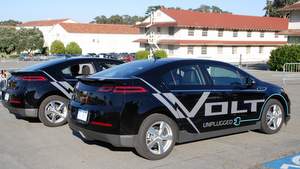These are not things that are going to mean the death of electric vehicles and may not even slow the solid momentum that plug-ins have built up over the past couple years. But they are not a good sign and definitely put a damper on some of the enthusiasm for alternatives to the traditional internal combustion engine. Here are three news items from the first week of 2013:
- Washington State started imposing a $100 registration surcharge on EVs to compensate for their lack of payment of fuel taxes that are used for road construction and upkeep.
- The Los Angeles International Airport is dropping its free parking for electric car program in the two lots that now provide it. Plug-in vehicle owners will now have to pay the $30 per day fee other parkers do, although the electricity to recharge their vehicle will remain free.
- Some Chevrolet dealers are deciding to stop carrying the plug-in Volt because of the added cost of tools needed to service it. Dealers were just informed they would need to pay $5,100 for tools to service the Volt (and the upcoming Cadillac ELR). Last year 2,614 Chevrolet dealers sold the Volt (out of 3,079 total Chevy dealerships). GM wouldn’t comment to Automotive News on how many dealers have opted out of the certified Volt program.

EV naysayers will undoubtedly take these as signs from Nostradamus that indicate plug-in cars are doomed to failure. On the other hand, rationale persons will point to other news from the week:
- The Chevy Volt, a plug-in that uses a small gas engine to recharge its batteries and extend its range beyond most electric-only models, had a record sales year, tripling sales compared to 2011 and ending up with 23,461 in sales. It will be joined in 2013 by the Spark EV and Cadillac ELR plug-in hybrid, which uses a similar propulsion system to the Volt.
- 12 plug-in vehicles, none of whom were on the market two years ago, sold more than 50,000 units in 2012, taking 0.6 percent of the total market.
- Just about every automaker has announced plans for future EV/plug-in models and prices are coming down.
- In spite of the $100 surcharge, the state of Washington is offering a 100 percent sales tax exemption for EVs.
- More than 40 gas-electric hybrids are now on the market, taking more than 3 percent of total sales.
- Incentives for the purchase of plug-ins continue to be offered by the federal government (an up to $7,500 tax credit) and several state governments, bringing the effective price of the cars into close to the range of comparable conventional vehicles when total cost of ownership is factored in.
- Non-financial incentives remain in many states, including carpool-lane access with a solo driver, preferential parking and free charging.
- Gasoline prices remain high, finishing 2012 at their highest average level ever.
Predictions for 2013 plug-in sales range from enthusiasts who hope for a culture shift that would allow EVs to take a major share of the market to more realistic analysts who expect growth less dramatic than the 200 percent increase in 2012 compared to 2011. That would still help this segment top 100,000 units, a significant milestone that conventional hybrids took much longer to attain. One factor to watch in plug-in sales will be the breakout between different models. As opposed to the hybrid market, which continues to be dominated by the Toyota Prius (and now by the Prius family of models), the early plug-in market has opened up to include as leaders models from at least four different manufacturers – the Prius Plug-in, Nissan Leaf, Chevy Volt and Ford C-Max Energi (with the Tesla Model S predicted by its producers to reach a similar level this coming year) all have similar sales numbers. This diversity with similar sales levels bodes well for a stronger growth as it spreads out upside as well as the potential risk should one model/company have a weak year. Here at Clean Fleet Report we’ll be keeping a close eye on all of those trends.
Published Jan. 6, 2013

Do we know how many of the 23,400 Volts were leased vs. purchased? I’m curious because if a lot of them were leased this fall as I suspect then there are going to be a lot of Volts for resale 2 years from now.